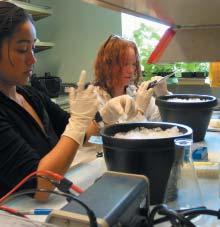
2 minute read
Briefs
Forecast Earth is available in select bookstores and online.
—Catherine Price
Advertisement
It’s the Cheese
Allison Clark has been a vegetarian since she was eight years old.But despi te occasionally dabbling with a dairy-free diet,this ‘05 Nutrition graduate has never been able to commit to veganism.Why? Because of cheese.
“I’m slightly cheese-obsessed,”admits Clark,who professes her love for chevre and the occasional sheep brie.It’s a taste she’s been developing over the past few years, ever since she worked on an oral history project about farmers markets in the Bay Area.Her frequent visits to the markets meant countless cheese samplings,which were so tasty that they sparked a deeper interest—not just in cheese as a food,but as a research subject.This resulted in her honors thesis,which examines the controversy in the United States over the safety of raw milk cheeses.
Raw milk cheese (that is,cheese made with unpasteurized milk) is illegal in the United States unless it has been aged for at least 60 days.This “60-day rule”is supposed to age cheese enough to kill harmful pathogens related to food-borne illness. But as Clark points out, new pathogens have emerged that can survive in cheese for longer than 60 days.More importantly,Clark’s research indicates today’s cheese manufacturing is so sophisticated and clean that even young raw cheeses can be made safely.In her paper,Clark suggests that the United States adopt a system similar to that of France,where certain small cheese companies are allowed to produce raw milk cheese,provided that they comply with strict sanitation requirements. Why is raw milk cheese such a big deal? Basically,because it tastes so good.
“There’s plenty of good pasteurized cheese,”says Clark,“but if you taste pasteurized and unpasteurized cheese side by side,they’re very different. Raw milk cheeses usually have a stronger taste and more interesting subtleties in flavor,because there are all these other unknown bacteria in there that are doing their own little interesting fermentations.” While there aren’t many nutritional advantages to eating raw milk cheese, Clark says that research has demonstrated that cheese made from unpasteurized milk can actually do good things for the body: it’s high in certain types of probiotics (that is,beneficial bacteria) that might be good for the gut.
Despite a lack of compelling nutritional motivation,Clark will still eat cheese, whether it’s made from raw or pastueurized milk.“I just haven’t been able to find a reasonable replacement,”she says.“I really like cheese.”
Boot Camp for Young Geneticists

Could you explain DNA’s role within a cell to a classroom of third graders? Isolate strawberry DNA? Create a polymerase chain reaction that screens for differences among potato species? Alexis Cavallaro and Paula Pereira can,and they’re still in high school. For six intense weeks this summer,the girls worked at Albany’s Plant Gene Expression Center in the genomics lab of Associate Professor Barbara Baker.They learned to extract and analyze plant DNA,set up their own experiments,and delved into bioinformatics.They taught young students and their own peers about DNA,and even traveled to Rockville,Md.,to visit the Institute for Genomic Research.
As part of the program,every member of Baker’s lab developed presentations for the teens.It’s a process that the program’s outreach director Meghan Flanagan says forces researchers to hone their skills at explaining their work to audiences of all levels.
Unlike in the past,this year Flanagan sought out students without a lot of academic support.“Our students in previous years were great,but they were already on the college track and probably would have had the opportunity to do research as undergraduates,”she says.“I wanted to find students who didn’t necessarily have all those opportunities,who were passionate about science,and for whom the experience could open some doors.”
She found just the right students in Pereira,who hopes to become a veterinarian,and Cavallaro,whose goal is to conduct genetic research on skin disorders such as lamellar icthyosis,a condition from which she herself suffers.While both girls had a steep learning curve going into the program,Flanagan says,“They had the opportunity to perform real genetics research,and it’s safe to say that both of them really get it.”
—Cyril Manning National Science Foundation funding for the Center for Plant Genomics Training and Education will expire this year.For information on helping to sustain the program, contact Alex Evans at (510) 643-9903.







